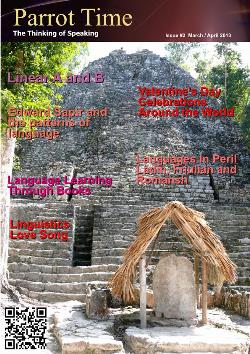
|
Easter Island, located in the southeastern Pacific Ocean, has two ancient mysteries related to it. The more famous of these are the huge statues, called Moai, which were created by the early Rapa Nui people and are located all over the island. The second mystery is related to a writing system which, to this day, remains undeciphered. Rongorongo is a system of glyphs that were carved into wood. Just over two dozen wooden objects of varying shape and size, containing these characters, have been collected and are kept in numerous museums and private collections. Even the natives of the island no longer retain the knowledge of what the writing means. The original description of the script, according to the natives, was kohau motu mo rongorongo, meaning "lines incised for chanting out". This got shortened to kohau rongorongo ("lines [for] chanting out"). Now it is just normally referred to as Rongorongo. History Polynesian people settled on Easter Island some time between from 300 to 1200 CE. The oral traditions of the Rapa Nui people claim that either Hotu Matu'a or Tu'u ko Iho, the two legendary founders of Rapa Nui, brought with them 67 tablets from their homeland of Marae Renga. This same founder is also said to have brought many indigenous plants like the toromiro tree, sweet potato, sugarcane, and paper mulberry. Despite them creating a strong culture and thriving for a long time, their isolation proved to be a major problem. As they became overpopulated, they used up most of the islands limited natural resources, including the already scarce trees. When European explorers arrived on the island in 1722, the population had gone from a thriving civilization of 15000 to one of just 3000. The Europeans caused the population to decline even further by exposing the natives to diseases they brought. Peruvians started raiding the island for free labor in the forms of slaves in the 1860s. Over the the years, hundreds of natives were taken, with few of them surviving long in Peru. When the Bishop of Tahiti put a stop to it, he had the surviving Rapa Nui natives sent back, but an epidemic of smallpox killed most of them on the ship. The survivors carried the sickness with them, and the remaining island population was nearly wiped out. The language Rapa Nui also suffered, as it became mixed with the widely spoken Tahitian. (For more information on the Rapa Nui language, see "Languages in Peril" in this issue).  One of the authentic tablets containing Rongorongo writing "Easter Island" got it's name from the Dutch explorer Jacob Roggeveen, who was the the island's first recorded European visitor. He found it on Easter Sunday, and so named it Paasch-Eyland, Dutch for "Easter Island". The official name of the island is Isla de Pascua, which also means "Easter Island". The Polynesian name for it, Rapa Nui, means "Big Rapa", which it got during the slave raids, because of its topographic similarity to the island of Rapa in the Bass Islands of the Austral Islands group. Spanish explorer Felipe González de Ahedo later traveled to the island in 1770 and claimed it for Spain. In 1888, Easter Island was annexed by Chile by Policarpo Toro, a Chilean naval officer, under the Tratado de Anexión de la isla ("Treaty of Annexation of the Island"). The Christian religion came to the island when Eugène Eyraud, a lay friar of the Congrégation de Picpus, landed on Easter Island on January 2, 1864, and began evangelizing the natives. He kept a record of his stay in which he also told of his discovery of the tablets when he first arrived. However, he did not mention the tablets again, so they remained unnoticed. He left nine months later, then returned as a full priest in 1865. He died a few years later of tuberculosis. Discovery Florentin-Étienne Jaussen, the Bishop of Tahiti, received a strange gift from the newly converted Catholics of Easter Island in 1868. It was a small wooden board with a long cord of human hair wound around it. On the board was a strange hieroglyphic writing. Wanting to learn more, Jaussen wrote to Father Hippolyte Roussel on Easter Island, instructing him to collect all the tablets and find some natives who were capable of translating them. Roussel could only recover a few of the tablets, and the natives could not agree on how to read them.  Copy made by Barthel of one of the tablets From Eyraud's records, they knew he had seen hundreds of tablets on his arrival only a few years earlier, so they wondered what had happened to all of them. Eyraud had also written that the natives had little interest in them. The Bishop questioned the island wise men, Ouroupano Hinapote and Tekaki, and they explained that while they knew how to carve the characters with a small shark's tooth, according to their teachings, there was nobody left on the island who knew how to read the characters. The Peruvians raids had caused the deaths of all the wise men who still knew how, and so the engraved pieces of wood were no longer of any interest to the natives. They simply burned them as firewood or wound their fishing lines around them. Some tablets were used to start fires by rubbing sticks against them. Some were even used in the construction of canoes. There were more attempts to recover tablets. Three more were obtained by Captain Gana from Chile in 1870, and German ethnologist Thomas Barthel found the decayed remains of half a dozen more tablets in caves in the 1950s. Creation From the various interviews of natives, the possible source and reason for the tablets was uncovered. Along with carved tablets, the founders brought around six hundred texts, written on a paper made of banana leaves. These texts were an archive of the history of the people, but as the leaves started to deteriorate, the archive was threatened. King Hotu Matua ordered the contents to be copied onto tablets made of toromiro wood. These texts were an archive of the history of the people, but as the leaves started to deteriorate, the archive was threatened. There was a particular group that was given this task. They were the tangata rongorongo, and were selected high officials from each clan. They lived in their own special dwellings and their sole job was to teach how to read and write the glyphs to others. They would conduct lessons under a banana tree, with their students seated around them in a circle. Through singing and reciting the stories of the text, the students learned what each character meant in it's entirety. Each text had a particular melody, so reading the text was very difficult if it's particular tune wasn't known. As they learned to read the texts, the students would also learn to carve the characters into the branches of banana leaves, using a small shark's tooth. When they had become proficient in that, they would be allowed to carve into toromiro wood. Toromiro wood was slow growing and in limited supply, however, so other kinds of wood were also used, including driftwood that would wash up on the island shore. Once a tablet had been carved, it was placed into a envelope made of reed leaves, then hung. After that, only teachers or their servants were allowed to touch them. Text Even though the natives no longer knew how to translate the texts, they did know how the various tablets were made. The process of cutting grooves into wood is called fluting and the grooves that are cut are called flutes. Scribes used obsidian flakes (pieces of a particular hard rock) or small shark teeth to flute the wood. Most of the glyphs are composed of two parts which are then connected by a fine cut. It is believed that the characters were created by first sketching the design using the obsidian, then a shark tooth would deepen the cuts. That would mean the remaining fine cuts may have been mistakes or some part of the design. Some of the carved tablets seem to have been carved with a steel blade, which makes the authenticity of those tablets questionable, perhaps done by someone trying to mimic or falsify the tablets. The glyphs are generally categorized as being forms of humans, animals, vegetables or geometric shapes. Those glyphs with "heads" are usually oriented up or facing right. A few are inverted (head down or facing left), but the reason for that is unknown. Some of the heads have markings on the side that might represent eyes or ears. A common glyph is a bird, with many resembling frigatebirds, which happens to be normally associated with Makemake (the creator of humanity, god of fertility and main god of the Tangata manu (birdman cult)). The direction of the text is also of interest. Normally, text is written in the same direction, vertically or horizontally. The texts of the Rongorongo script is written in alternating directions, starting from the lower left corner. A line is read from left to right, but upon reaching the end, the tablet is then turned upside down, and the next line is then read. The lines above and below the one being read would be upside down. This system is called reverse boustrophedon. The script contains no punctuation or paragraphs. |
| Rongorongo - Island Chants | ||||||||||||
| Writer: | Lucille Martin | |||||||||||
| Images: | ||||||||||||
| ||||||||||||
| Sources: | ||||||||||||
| ||||||||||||
All images are Copyright - CC BY-SA (Creative Commons Share Alike) by their respective owners, except for Petey, which is Public Domain (PD) or unless otherwise noted.
comments powered by Disqus


















